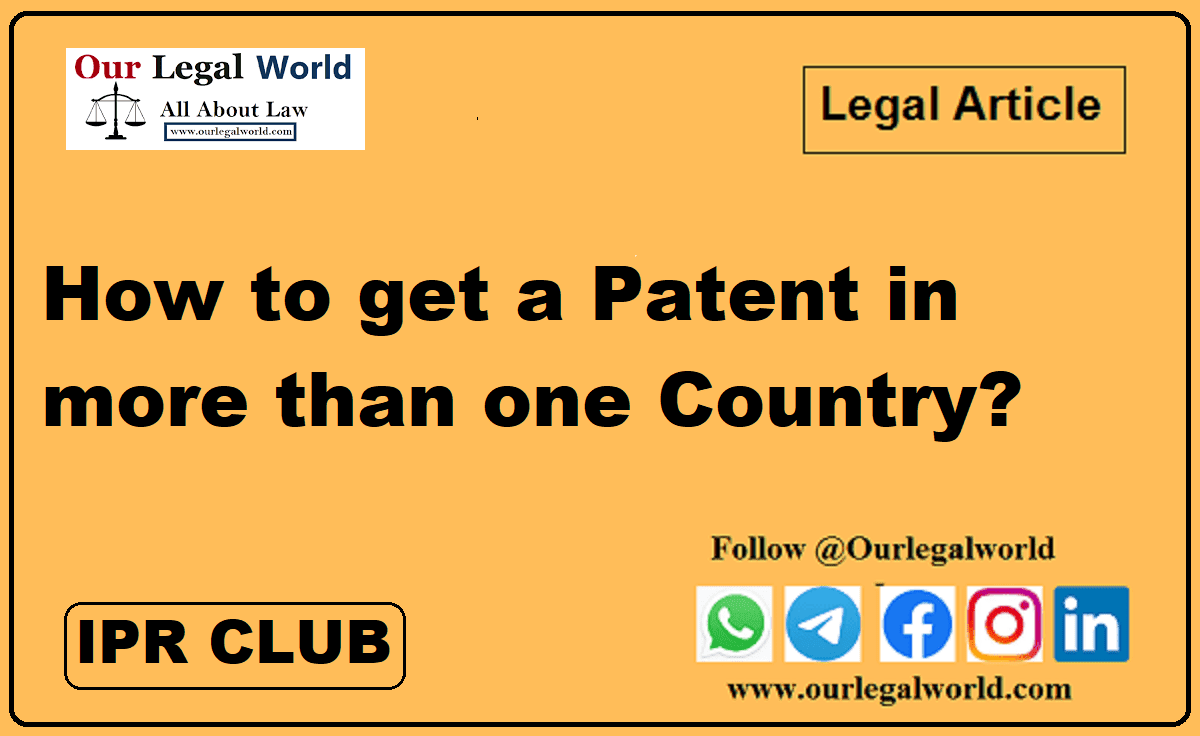How to get a Patent in more than one Country?- IPR Club OurLegalWorld
Written by: Palak Rajpal [Bharati Vidyapeeth, New Law College, Pune]
Introduction
With new technologies coming up every day like the new apple vision pro or simply a new feature in an iPhone, Patenting has become an everyday activity. Technological products or any product for that matter which is unique and is manufactured and supplied by a Multinational Company all over the Globe require a patent. But the question arises as to how can one sit in one Nation but have a patent right in multiple nations because a patent is a territory bound. It means that when one applies for a patent and receives it, that right is limited to the territorial boundary of that state only, irrespective of the reach of the patented product. The following article deals with this question.
Also Read: Examining the Limits of Performer Rights of Sportspersons: The Copyright Act, 1957
Procedure to get a patent in a Foreign Country if you are an Indian
An Indian national has two ways of getting a patent for his/her invention; either by applying in a Convention Nation and then within the next twelve months in India for a patent or by filing a single application under the Patent Cooperation Treaty (PCT) known as an International Application.
Application made in a Convention Country
Section 133[1] of the Patent Act, 1956 defines a Convention Country. A convention Country is one which is a signatory to a treaty of which India is also a member. The Convention Country provides citizens of India or of any other member nation similar rights with respect to grant and protection of patents as it would provide to its own citizens.
A Convention application herein is first filed in a convention Country/Countries and then within twelve months in India. The date on which the Convention Application (Basic Application) is filed in the Convention Country is treated as the priority date of that application[2].
A Convention Application should contain the following:
- A Complete Specification
- Date and Name of the Convention Country where the basic application has been filed.
- An undertaking specifying that no application prior to this has been filed by the applicant or by the person from whom he has attained his title for the same Invention[3].
Conditions With Respect to Foreign Applications:
Section 8[4] of the Patents Act,1860 specifies certain conditions or criteria that are to be fulfilled when an application is filed by a person or by someone from whom he has attained his title for the same invention in a foreign country and in India.
The applicant along with his patent application must submit the following:
- Details of the Foreign Application
- An undertaking stating that the applicant will inform the controller of all the other foreign applications till the grant of patent in India.
- Information of the process and status of all the foreign applications filed for the patent till the grant or refusal of Patent in India.
The above conditions are only for those applications which are for the same inventions and not two different ones.
Once a Convention Patent is filed it is the discretion of the respective Countries whether to provide the patent or not. The grant of Patent is subjected the essentials and other conditions as per the law of the land.
Application made through a Patent Cooperation Treaty (PCT).
The other method through which one can get a patent in multiple countries is by filing a single application through PCT. PCT is an international treaty that binds various countries around the globe.
The process of filing an application through PCT is as follows[5]:
Filing- an international application is to be filed with a national or regional patent office, or directly at WIPO. The application should comply to all the requirements set out in the Treaty and Regulations, that are binding on all the contracting states. Usually done on the expiry of 12 months from filing of a local application (As far as Indian applicant is concerned who has filed a patent application in India; Local application date is treated as the priority date of the patent application)[6].
International Search- After the application is successfully filed an “International Searching Authority (ISA) investigates the patent documents which may have an effect on whether the invention is patentable or not. A written opinion is also provided by the said authority. The search is done within four months of the filing of an application.
International Publication- On expiry of eighteen months from the priority date and a successful international search the patent details are made public across the globe.
Supplementary and Preliminary International Search- Both steps are optional. They are carried out on the request of the applicant. It is an additional search to analyse what may have been left out or neglected in the prior search.
National Phase- After the above-mentioned procedure is completed, at the end of thirty months from which the applicant is claiming priority the applicant must directly deal with the respective state authorities where he/she wants to seek a patent. To enter this phase all the requirements set out in the rules and regulations must be fulfilled. These requirements are mentioned under the PCT Applicant’s Guide.
Conclusion
It can be concluded that an invention can be protected in Multiple Countries and not just one. The inventor must just go through with either of the above two methods to do so. With advancement in technology and the growth of the e-world protection of inventions in multiple countries at once has become a necessity. Regardless of the location, new inventions are now available for everyone to use worldwide, hence, due credit should be given to the inventor, PCT ensures that.
[1] Section 133, Patent Act, 1956
[2] Section 135, Patent Act, 1956
[3] Section 135, Patent Act, 1956
[4] Section 8, Patent Act, 1956
[5] Protecting your Inventions Abroad, WIPO, https://www.wipo.int/pct/en/faqs/faqs.html, 12-06-2023
[6] Section 135(3), Patent Act, 1956








